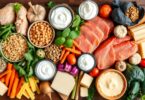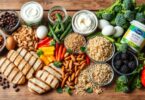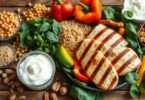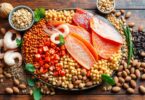“The food you eat can be either the safest and most powerful form of medicine or the slowest form of poison.” – Ann Wigmore, holistic health pioneer.
Protein is a critical macronutrient, essential for a balanced diet. It aids in muscle building, repair, and supports immune function and weight management. Including protein-rich foods in your meals is vital for overall health and fitness. This article will delve into the 15 best protein sources for a healthy diet.

Key Takeaways
- Protein is essential for muscle growth, repair, and recovery.
- Animal-based protein sources like lean meats, poultry, seafood, and dairy provide complete proteins.
- Plant-based protein options like legumes, nuts, seeds, and whole grains can also be incorporated for a balanced diet.
- Timing your protein intake throughout the day is important for maximizing its benefits.
- Incorporating a variety of high-protein foods can help you meet your daily nutritional needs.
Understanding the Importance of Protein in Your Diet
Protein is a critical macronutrient, essential for our health and well-being. It facilitates the construction and repair of tissues, aids in muscle growth and recovery, and serves as a consistent energy source. Recognizing the role of protein in your diet is key to fostering a balanced, nutritious lifestyle.
Daily Protein Requirements by Age and Activity Level
The daily protein intake varies with age, gender, and activity level. Adults typically need 0.8-1 gram of protein per kilogram of body weight daily. Yet, individuals with higher activity levels or those aiming to build muscle might require up to 1.6-2.2 grams per kilogram. It’s vital to evaluate your specific needs and consult a healthcare professional to determine the ideal protein intake for your goals and lifestyle.
Benefits of High-Protein Foods for Health
- Supports muscle growth and maintenance
- Aids in weight management by promoting feelings of fullness and satiety
- Helps maintain healthy bones and teeth
- Boosts immune function and overall well-being
- Provides sustainable energy throughout the day
Role of Protein in Muscle Building and Recovery
Protein is vital for muscle repair and growth, making it essential for strength training or muscle building. Consuming sufficient high-quality protein, especially around workout times, aids in muscle recovery and supports muscle growth. This not only improves physical performance but also contributes to a robust, healthy body.
“Protein is the building block of muscle, and without it, your body cannot effectively build or repair muscle tissue.”
Essential Lean Meats for Optimal Protein Intake
Lean meats are pivotal for muscle building and health. They offer high-quality protein and numerous beneficial nutrients. This makes them essential in any diet focused on protein.
Chicken breast is a standout lean protein source. It is low in fat but rich in 26 grams of protein per 3.5-ounce serving. Chicken also provides B vitamins, selenium, and minerals that support bodily functions.
Turkey is another high-protein lean meat. It can be roasted, grilled, or consumed as deli slices. A 3.5-ounce serving of turkey breast contains about 24 grams of protein, along with essential vitamins and minerals.
Lean beef options like sirloin, round, and 93% lean ground beef are excellent choices. These cuts offer 20-24 grams of protein per 3.5-ounce serving. They also provide iron, zinc, and B vitamins.
Pork tenderloin is a top lean protein food. It contains around 22 grams of protein per 3.5-ounce serving and is low in fat. This makes it ideal for muscle building or maintaining a healthy weight.
Including these lean protein-rich meats in your diet can help meet daily protein needs. It supports overall health and wellness.
| Lean Protein Food | Protein (g) per 3.5 oz | Additional Key Nutrients |
|---|---|---|
| Chicken Breast | 26 | B Vitamins, Selenium |
| Turkey Breast | 24 | B Vitamins, Minerals |
| 93% Lean Ground Beef | 22 | Iron, Zinc, B Vitamins |
| Pork Tenderloin | 22 | B Vitamins, Minerals |

Protein-Rich Foods for a Balanced Diet
The significance of protein in a balanced diet is paramount. It aids in muscle growth and recovery, and enhances feelings of fullness and energy. Understanding the distinction between complete and incomplete proteins is crucial. This knowledge enables the strategic combination of these sources for optimal benefits.
Complete vs. Incomplete Protein Sources
Animal-based products, such as meat, eggs, and dairy, are complete proteins. They contain all essential amino acids necessary for human health. Conversely, plant-based foods, like legumes and grains, are incomplete proteins, lacking one or more amino acids. A diverse intake of best protein for fitness and protein-rich meals is essential to achieve a complete amino acid profile.
Combining Protein Sources for Maximum Benefits
Pairing incomplete protein sources, such as legumes with whole grains, creates a complete protein profile. This strategy not only fulfills daily protein requirements but also broadens the spectrum of nutrients. For instance, combining protein foods for breakfast like eggs with whole-grain toast can foster a healthy protein diet that promotes overall health.
Timing Your Protein Intake Throughout the Day
The timing of protein intake is equally important for fitness and health. Consuming protein evenly throughout the day, rather than in one large meal, optimizes muscle protein synthesis. This approach keeps you satisfied and energized.
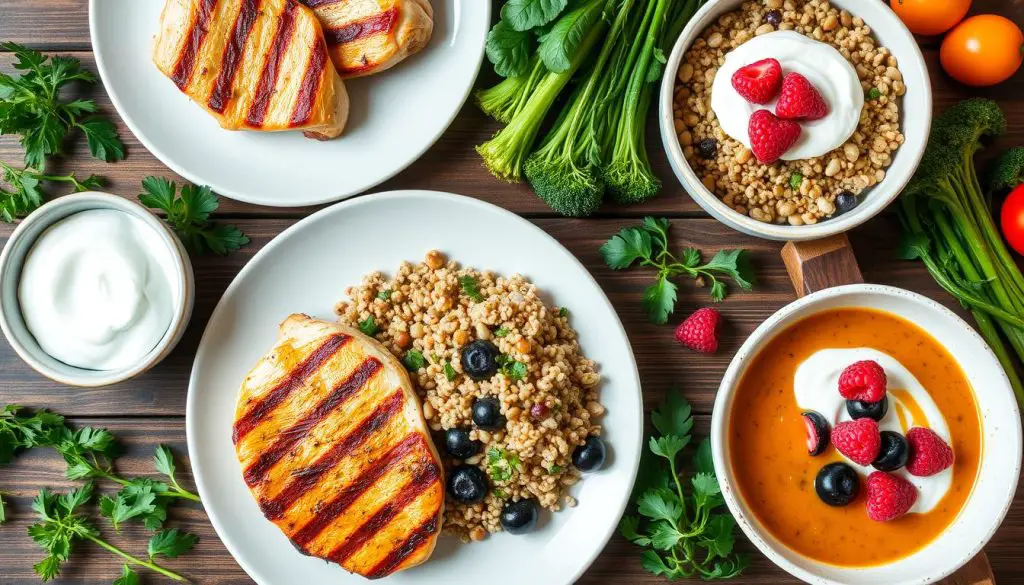
Seafood Options High in Protein and Omega-3s
Seafood emerges as a premier choice for those seeking protein-rich foods. It is not only abundant in high-quality protein but also in essential omega-3 fatty acids. This combination provides unparalleled benefits for health and muscle growth.
Wild-caught salmon, tuna, and sardines are among the top seafood options for a protein-rich diet. These fish are excellent sources of lean, complete proteins, offering a full spectrum of essential amino acids. Moreover, the omega-3s in these fish reduce inflammation, support heart health, and enhance brain function.
| Seafood Option | Protein Content (per 3.5 oz serving) | Omega-3 Content (per 3.5 oz serving) |
|---|---|---|
| Wild-Caught Salmon | 22 grams | 2.2 grams |
| Canned Tuna | 25 grams | 0.5 grams |
| Sardines | 23 grams | 1.9 grams |
For individuals looking for the best protein options, seafood is an excellent choice. It combines high-quality protein with heart-healthy omega-3s, making it a nutritional powerhouse. This combination supports muscle growth, weight management, and overall wellness.
“Seafood is a fantastic source of protein that’s also low in calories and high in essential nutrients. It’s a great choice for anyone looking to improve their health and fitness.”
Whether you prefer grilling, baking, or incorporating seafood into your favorite recipes, exploring the wealth of protein-rich and omega-3-packed options can be a delicious and nutritious way to elevate your diet and support your overall well-being.
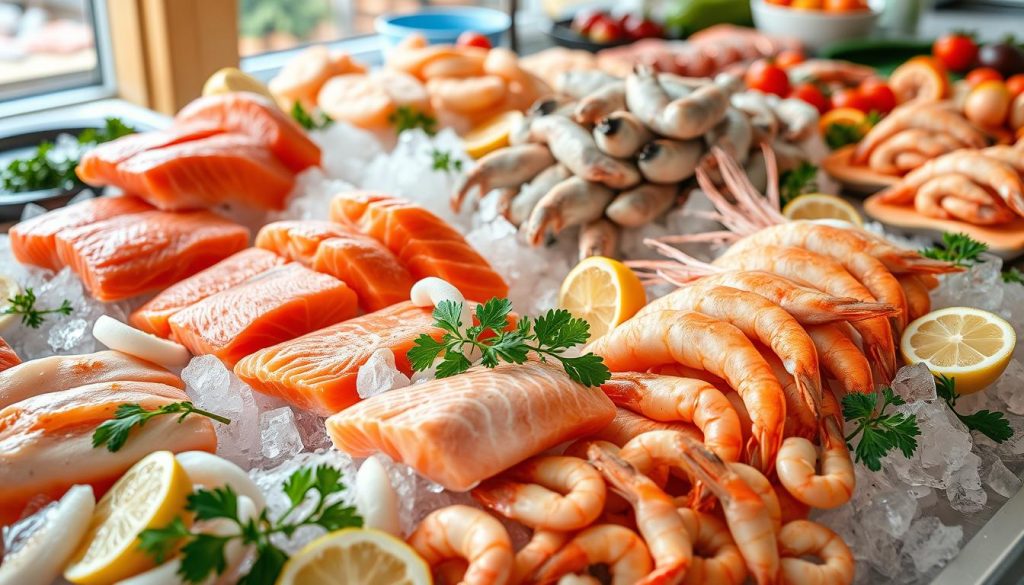
Plant-Based Protein Sources for Vegetarians and Vegans
For individuals on a vegetarian or vegan diet, it is essential to include high-quality protein sources for health maintenance. Animal-based proteins are often considered complete. However, the plant kingdom provides a plethora of nutritious, protein-rich options to meet daily protein needs.
Best Legumes for Protein Content
Legumes, including beans, lentils, and peas, are significant in plant-based protein. These ingredients can be easily integrated into various vegetarian and vegan dishes. Among the top legumes for protein are:
- Lentils (18-26g of protein per cup, cooked)
- Chickpeas (15g of protein per cup, cooked)
- Kidney beans (15g of protein per cup, cooked)
- Black beans (15g of protein per cup, cooked)
- Edamame (17g of protein per cup, cooked)
Nuts and Seeds as Protein Alternatives
Nuts and seeds also serve as excellent plant-based protein sources. These foods are rich in nutrients and can be enjoyed as snacks, added to salads, or included in high-protein vegetarian meals and healthy protein-rich meals. Notable options include:
- Almonds (6g of protein per 1-ounce serving)
- Chia seeds (4.7g of protein per 1-ounce serving)
- Pumpkin seeds (5g of protein per 1-ounce serving)
- Pistachios (6g of protein per 1-ounce serving)
- Hemp seeds (10g of protein per 3-tablespoon serving)
Incorporating a variety of protein foods for vegans and vegetarian protein foods into your diet ensures you meet daily protein requirements. This supports overall health and wellness.
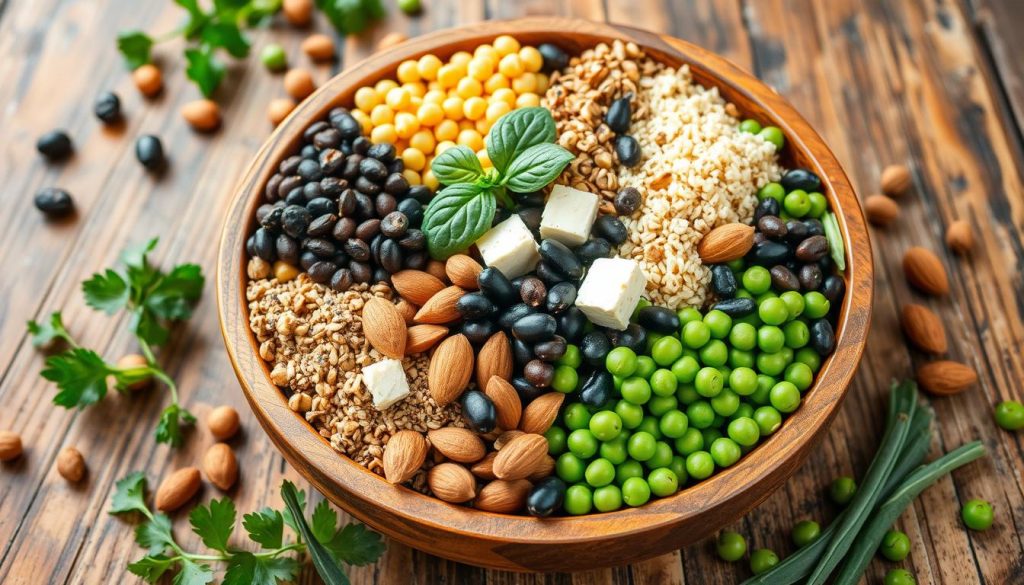
Dairy Products and Eggs as Complete Protein Sources
Dairy products and eggs are paramount among protein-rich foods. They serve as a superior source of protein for individuals of all genders.”. Moreover, they are replete with essential nutrients, bolstering health and wellness.
Greek yogurt emerges as a notable dairy option. It is dense with up to 23 grams of protein per serving. This makes it an ideal high-protein snack or meal enhancer. Cottage cheese, with 28 grams of protein-rich foods for weight gain per cup, is another dairy gem.
- Eggs, a complete protein source, encompass all essential amino acids our bodies require. A single large egg contributes 6 grams of protein for individuals of all genders.
- Cheese, like cheddar or Swiss, is a handy and protein-rich food for your diet. It contains roughly 7-8 grams of protein per ounce.
The adaptability of dairy products and eggs facilitates their integration into diverse meals and snacks. They can be found in omelets and frittatas, yogurt-based smoothies, and cheese-topped salads. These protein-rich foods aid in fulfilling daily protein requirements, enriching your diet with flavor and nutrition.
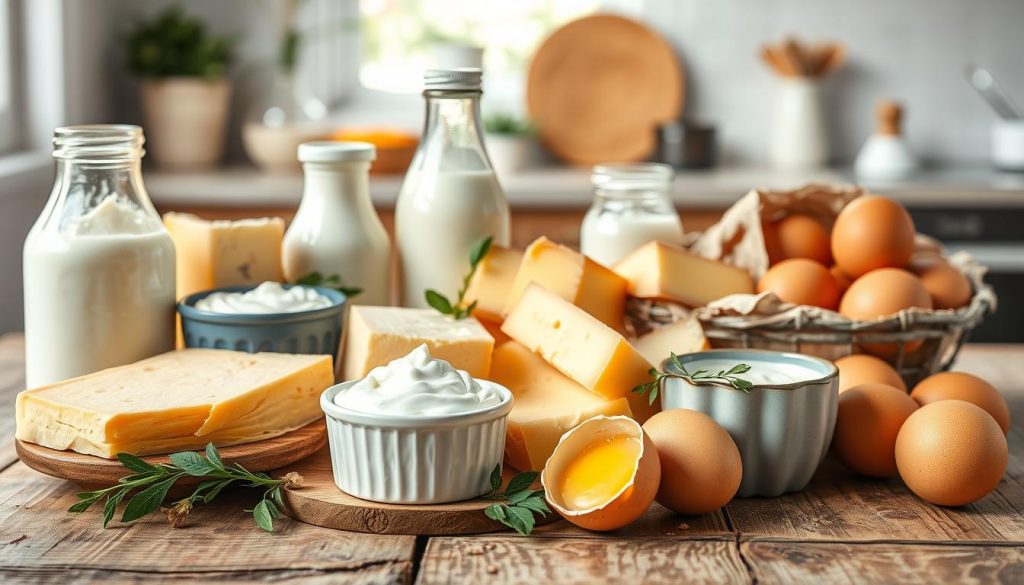
“Dairy products and eggs are excellent sources of complete, high-quality protein that can support muscle building, weight management, and overall health.”
Whole Grains with Surprising Protein Content
Many individuals immediately associate protein with lean meats, eggs, and dairy. Yet, whole grains offer unexpected protein sources that can significantly enhance nutrition. These grains are particularly beneficial for athletes, those seeking low-fat protein, and parents aiming to increase protein in their children’s diets.
Ancient Grains and Their Protein Profiles
Ancient grains, such as quinoa, amaranth, and teff, have become increasingly popular for their nutritional benefits, including high protein content. For instance, a cup of cooked quinoa contains about 8 grams of protein, making it an excellent protein source for athletes or anyone looking to enhance their protein-packed breakfast ideas. Amaranth, another ancient grain, offers around 9 grams of protein per cup, ideal for both kids and adults.
Incorporating Protein-Rich Grains into Meals
Integrating these protein-rich whole grains into your diet is a straightforward method to increase protein intake. Consider adding quinoa to your protein-packed breakfast ideas, such as a quinoa breakfast bowl with fresh fruit and nuts. Amaranth can be a great addition to soups, stews, or baked into breads and muffins for a nutritious boost. Experiment with different ancient grains to discover new ways to incorporate low-fat protein foods into your diet and create protein-rich foods for kids they’ll enjoy.
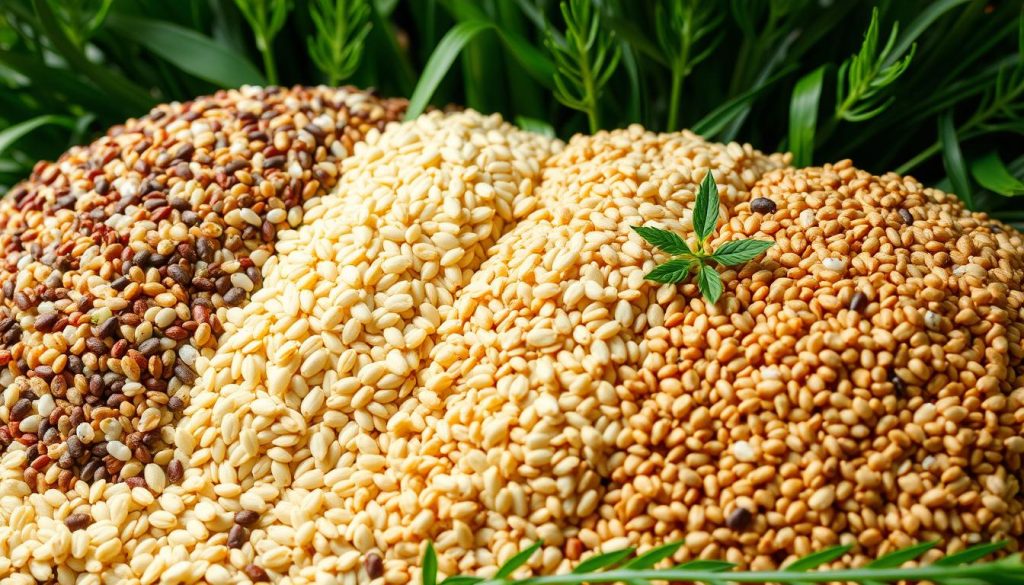
| Grain | Protein Content (per cup, cooked) |
|---|---|
| Quinoa | 8 grams |
| Amaranth | 9 grams |
| Teff | 10 grams |
| Brown Rice | 5 grams |
| Oats | 6 grams |
High-Protein Snacks for Energy and Satiety
Adhering to a high-protein diet can be daunting, especially when seeking satisfying snack options. Fortunately, numerous protein-rich snacks exist, offering energy boosts and satiety. These snacks are ideal for those pursuing fitness goals or simply desiring a nutritious snack. Incorporating these protein-packed choices into your diet plan is advisable.
Greek yogurt stands out as a simple, convenient snack. It is rich in high-quality protein and probiotics. Enjoy it solo or with fresh berries, nuts, or honey for a delightful, filling treat. Hard-boiled eggs are another portable option, delivering a concentrated protein dose to sustain you throughout the day.
For those desiring a more substantial snack, protein bars can be transformative. Opt for bars with high-quality protein sources like whey or casein, and steer clear of those with excessive added sugars. Roasted chickpeas and edamame also excel as protein-rich snacks, offering a crunchy texture and a rich flavor.
- Greek yogurt with berries
- Hard-boiled eggs
- Protein bars
- Roasted chickpeas
- Edamame
Incorporating these high-protein snacks into your routine can fuel your body with essential nutrients. It also helps curb cravings and promotes a feeling of fullness. Whether you’re on a high-protein diet or simply aiming to increase your daily protein intake, these snacks will quickly become favorites.
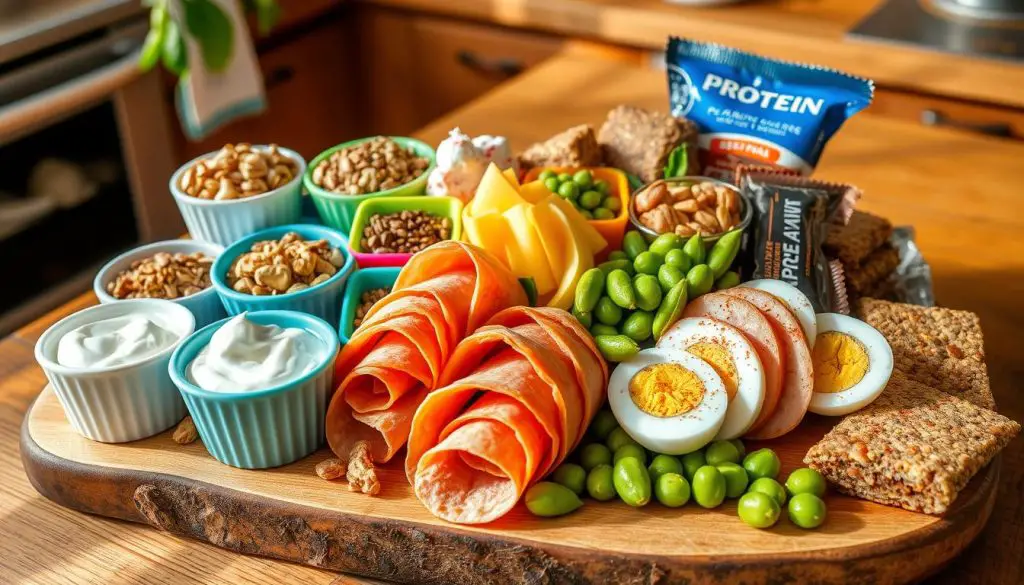
“Snacking on protein-rich foods can help you feel more satisfied and less likely to overeat later in the day.”
Protein-Rich Foods for Weight Management
Integrating protein-rich foods into your diet can revolutionize your approach to weight management. Protein’s role in enhancing satiety is pivotal, allowing you to feel more satiated for longer periods. This reduction in hunger pangs can prevent overeating. Furthermore, protein’s ability to elevate metabolism aids in calorie burning, facilitating the maintenance of a healthy weight.
How Protein Aids in Weight Loss
Protein-rich foods digest more slowly, prolonging their stay in the stomach and fostering a sense of fullness. This can effectively curb cravings and snacking, making adherence to a calorie-controlled diet more manageable. Additionally, protein’s higher thermic effect compared to carbohydrates or fats means your body expends more calories to process it.
Best Protein Sources for Calorie Control
- Lean meats such as chicken, turkey, and lean cuts of beef or pork are excellent protein sources that are also low in calories.
- Fish and seafood, such as salmon, tuna, and shrimp, provide high-quality protein along with heart-healthy omega-3 fatty acids.
- Eggs are a versatile and nutrient-dense protein option that can be easily incorporated into meals and snacks.
- Legumes, including lentils, chickpeas, and beans, offer a plant-based source of protein that is also high in fiber, which can aid in weight loss.
- Greek yogurt is a creamy, protein-rich dairy option that can be used in smoothies, dips, or as a topping for meals.
| Protein Source | Protein Content (per serving) | Calorie Count (per serving) |
|---|---|---|
| Grilled Chicken Breast | 27g | 165 calories |
| Baked Salmon | 23g | 182 calories |
| Lentils | 18g | 230 calories |
| Greek Yogurt (non-fat) | 17g | 100 calories |
By integrating these protein-rich foods into your diet, you can experience enhanced satiety, increased metabolism, and better calorie control. These benefits collectively support your weight management objectives.
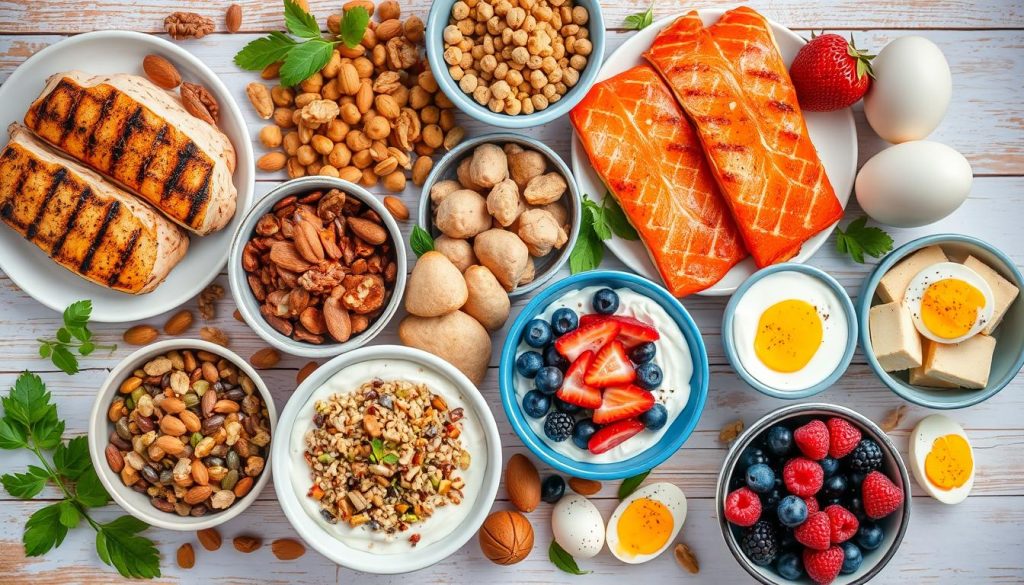
Meal Planning with Protein-Rich Ingredients
Creating balanced meals that satisfy both your body and palate is achievable. By integrating protein-rich ingredients into your meal planning, you open up a realm of culinary exploration. This approach supports your health and fitness objectives, whether you aim to enhance muscle mass, reduce weight, or maintain a nutritious regimen. Strategic meal planning with protein-rich foods can significantly alter your dietary experience.
Begin your day with a protein-rich breakfast that energizes you through the morning. Scrambled eggs with avocado and whole-grain toast, or a smoothie with Greek yogurt, berries, and protein powder, are excellent choices. For lunch, opt for grilled chicken breast, roasted salmon, or plant-based alternatives like lentil soup or a quinoa and chickpea salad. Lean protein sources such as bison, turkey, or tofu are ideal for a muscle-building meal at dinner.
To ensure a diverse intake of healthy foods with protein, incorporate the following into your weekly meal plan:
- Lean meats: chicken, turkey, lean beef, bison
- Seafood: salmon, tuna, shrimp, tilapia
- Legumes: lentils, chickpeas, black beans, edamame
- Dairy: Greek yogurt, cottage cheese, low-fat milk
- Whole grains: quinoa, brown rice, oats, barley
- Plant-based proteins: tofu, tempeh, seitan, nut butters
By focusing on these protein-rich ingredients, you’ll enjoy not only delicious but also nutritious meals. These meals support muscle repair, immune function, and overall health. Experiment with new recipes and flavors to keep your meals exciting and your nutrition balanced.
| Protein-Rich Meal | Ingredients | Nutritional Benefits |
|---|---|---|
| Grilled Salmon and Quinoa Salad | Salmon, quinoa, mixed greens, cherry tomatoes, avocado, lemon dressing | Omega-3 fatty acids, complete protein, fiber, vitamins, and minerals |
| Chicken Stir-Fry with Broccoli and Brown Rice | Chicken breast, broccoli, bell peppers, brown rice, soy sauce, ginger | Lean protein, antioxidants, complex carbohydrates, and B vitamins |
| Lentil and Sweet Potato Curry | Lentils, sweet potatoes, coconut milk, curry powder, spinach, garlic | Plant-based protein, complex carbs, vitamins A and C, and fiber |
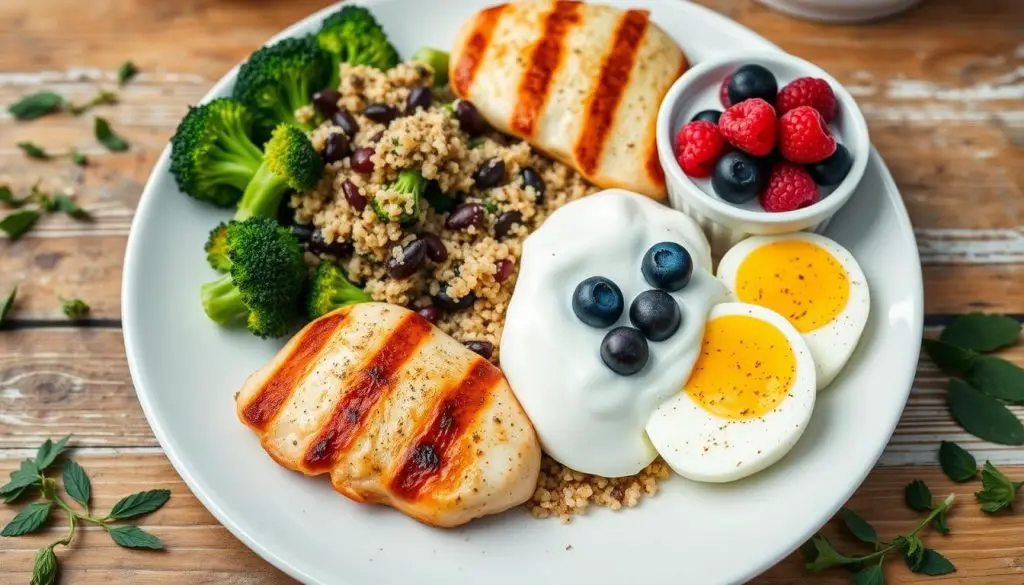
“Protein is the building block of muscle, and muscle is the engine of your metabolism. Incorporating protein-rich foods into your meals is crucial for overall health and fitness.”
Common Myths About Protein Consumption
Exploring the realm of high-protein vegetarian foods and plant-based protein sources necessitates the dispelling of prevalent myths and misconceptions. This section aims to illuminate the scientific truths behind protein-rich diets and their impact on muscle and overall health.
Debunking Protein Myths and Misconceptions
A widespread myth posits that high-protein foods are exclusively found in meat and dairy. However, numerous protein-rich foods for health originate from plant-based sources, including legumes, nuts, seeds, and whole grains. This allows vegetarians and vegans to fulfill their protein-rich diet for muscle needs through a well-balanced diet.
Another misconception is that excessive protein consumption is detrimental to health. Yet, studies indicate that most healthy adults can safely ingest up to 2 grams of protein per kilogram of body weight daily without adverse effects. The crucial aspect is to focus on high-protein vegetarian foods and maintain a balanced diet.
Science-Based Facts About Protein Intake
- Protein is vital for tissue building and repair, immune function support, and energy provision.
- The daily protein intake recommendation for adults ranges from 0.8-1.2 grams per kilogram of body weight, influenced by activity level and age.
- Protein from plant-based protein sources is equally effective as animal-based protein for muscle building and recovery.
- Timing your protein intake throughout the day, including post-exercise, can enhance the benefits of a protein-rich diet for muscle.
By grasping the scientific facts about protein consumption, individuals can make informed choices regarding the inclusion of protein-rich foods for health in their diets. This applies to both meat-eaters and vegetarians.
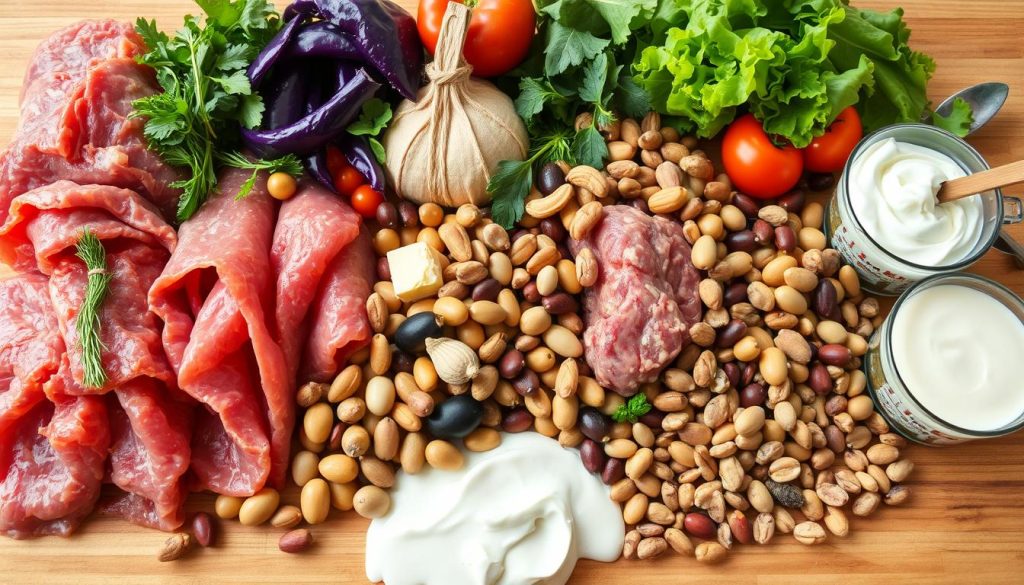
Tips for Incorporating More Protein in Your Diet
Adopting a diet rich in protein is crucial for maintaining health, supporting muscle development, and ensuring energy levels remain high throughout the day. If you aim to enhance your protein consumption, several practical strategies can aid you:
- Prioritize Lean Protein Sources: Focus on lean meats, poultry, fish, and plant-based alternatives like beans, lentils, and tofu to enrich your protein foods to include in your diet.
- Incorporate High-Protein Snacks: Emphasize healthy eating with protein by choosing snacks such as Greek yogurt, hard-boiled eggs, or a mix of nuts and seeds.
- Experiment with Protein-Rich Recipes: Venture into new culinary territories with dishes loaded with protein, such as quinoa bowls, grilled salmon, or vibrant stir-fries.
- Time Your Protein Intake: Ensure a balanced intake of protein foods to include in your diet by spreading it evenly across meals and snacks.
- Supplement with Protein Powders: If dietary sources alone are insufficient, consider integrating a high-quality protein supplement into your regimen.
By integrating these strategies into your healthy eating with protein regimen, you can effortlessly elevate your protein consumption. This supports your fitness and health objectives effectively.
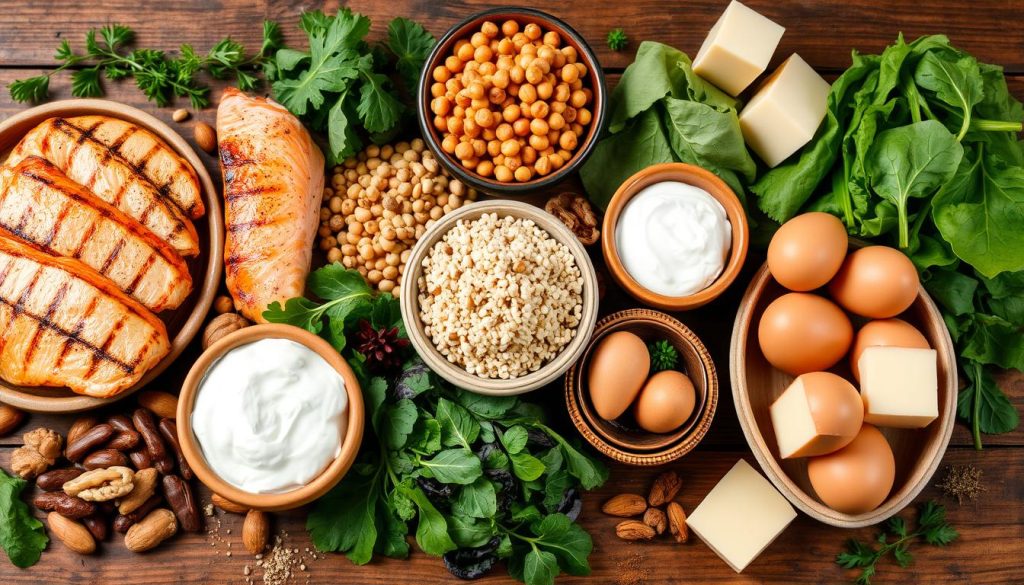
“Protein is the building block of our bodies, and it’s essential for maintaining muscle mass, supporting immune function, and promoting overall health.”
| Protein-Rich Food | Protein Content (per serving) |
|---|---|
| Chicken Breast | 27g |
| Salmon | 22g |
| Eggs | 6g |
| Lentils | 18g |
| Greek Yogurt | 17g |
Conclusion
This comprehensive guide has delved into the critical role of protein-rich foods in a balanced diet. We’ve examined lean meats, seafood, plant-based sources, and dairy products. These high-protein options are vital for muscle building, recovery, and overall health.
Understanding daily protein needs and the benefits of various sources empowers you to make better dietary choices. Whether your goal is weight management, muscle growth, or a nutritious diet, this guide equips you with the knowledge. It helps you optimize your protein intake and reach your health objectives.
A diverse and balanced diet, rich in protein, is essential for a healthy lifestyle. Incorporating protein-rich foods into your daily routine fuels your body, increases energy, and supports wellness. Explore the wide range of protein-rich options available and start your journey towards a healthier, more vibrant life.
FAQ
What are the best protein-rich foods for a healthy diet?
Optimal protein sources include lean meats such as chicken, turkey, and lean beef. Seafood like salmon and tuna also offer high protein content. Dairy products, including Greek yogurt and cottage cheese, are rich in protein. Eggs, legumes, nuts, and seeds, along with whole grains like quinoa and amaranth, round out the list.
How much protein do I need in my daily diet?
Daily protein needs vary by age, activity level, and health status. Adults generally require 0.8-1.2 grams of protein per kilogram of body weight. Those who are more active or seeking muscle growth may need 1.6-2.2 grams per kilogram.
What are the benefits of consuming high-protein foods?
High-protein foods support muscle growth and repair, and maintain a healthy metabolism. They also promote satiety and provide sustained energy. Additionally, protein is vital for immune function, bone health, and overall wellness.
How can protein help with muscle building and recovery?
Protein is crucial for muscle tissue growth and repair. Adequate high-quality protein, especially with strength training, aids in muscle development and maintenance. It plays a key role in muscle protein synthesis, essential for muscle health.
What are some examples of lean protein-rich meats?
Lean meats include chicken breast, turkey breast, 93% lean ground beef, pork tenderloin, and bison. These options are low in fat and high in protein, making them ideal for a balanced diet.
What are the differences between complete and incomplete protein sources?
Complete protein sources, like animal-based foods, contain all essential amino acids. Incomplete protein sources, mostly plant-based, lack one or more amino acids. Combining different incomplete sources or including a complete protein in meals is necessary for a full amino acid profile.
How can I time my protein intake throughout the day?
Distributing protein intake across meals and snacks maximizes benefits. Include a protein source at each meal, such as eggs or Greek yogurt at breakfast, lean meat or fish at lunch, and legumes or nuts at snacks. This consistent intake supports muscle growth, recovery, and health.
What are some high-protein seafood options?
Seafood is a lean, high-quality protein source. Salmon, tuna, cod, shrimp, and sardines are rich in protein and omega-3 fatty acids, offering additional health benefits.
What are some plant-based protein sources for vegetarians and vegans?
Vegetarians and vegans can find protein in legumes, tofu, tempeh, quinoa, nuts, and seeds. Whole grains like amaranth and buckwheat also provide protein. Combining these sources ensures a complete amino acid profile.
How can dairy products and eggs contribute to my protein intake?
Dairy products like Greek yogurt, cottage cheese, and milk are high in complete protein. Eggs, with both yolk and white, are also protein-dense. Incorporating these into your diet boosts overall protein intake.
What are some high-protein snack options?
High-protein snacks include Greek yogurt with berries, hard-boiled eggs, nuts, seeds, protein bars, smoothies, edamame, and string cheese. These options provide a protein boost, helping to maintain energy and fullness between meals.
How can protein-rich foods aid in weight management?
Protein-rich foods support weight management by promoting fullness and reducing calorie intake. They also have a higher thermic effect, meaning the body burns more calories digesting them. Including lean protein sources in your diet aids in weight loss and maintaining a healthy weight.
What are some common myths about protein consumption?
Common myths include the belief that high-protein diets harm the kidneys and that supplements are necessary for muscle growth. Research shows balanced, protein-rich diets are beneficial when consumed in moderation, debunking these myths.

